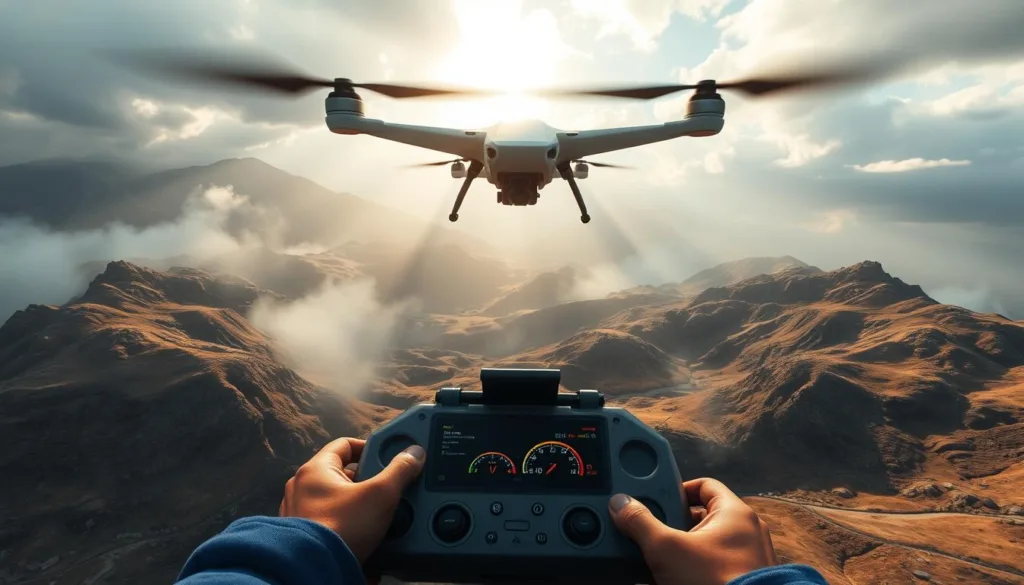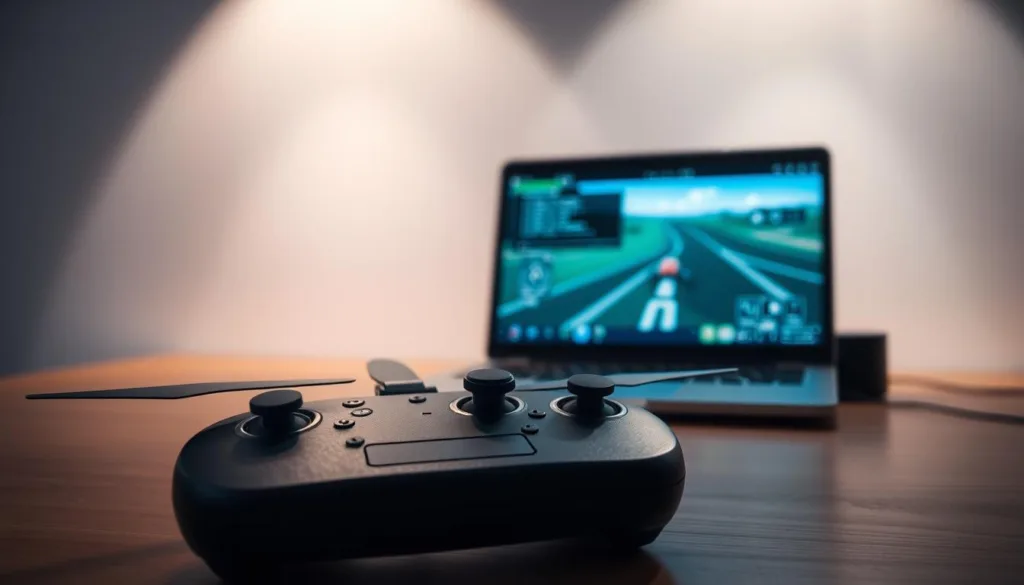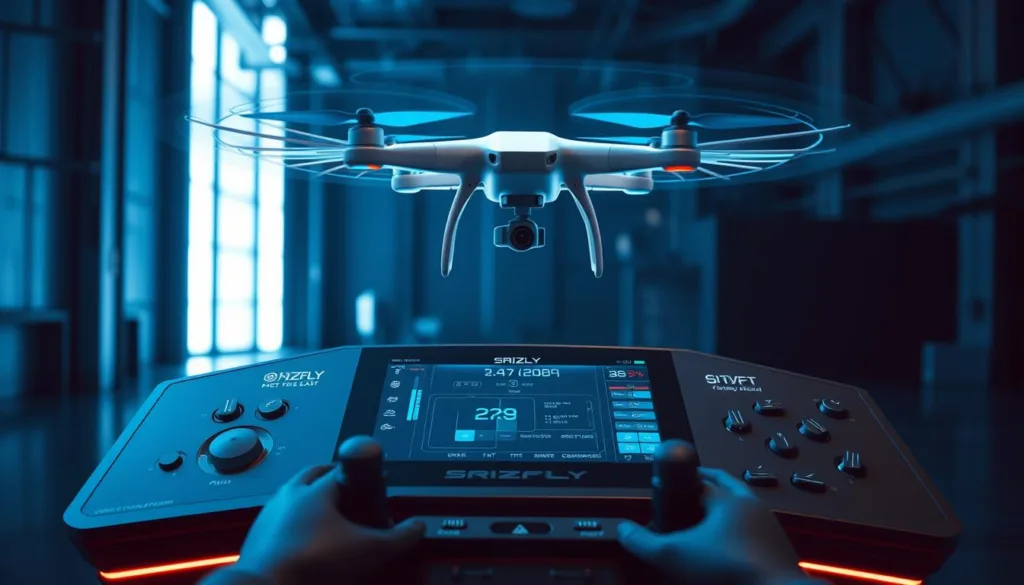Welcome to the world of precision skill-building for modern aerial operations. Whether you’re new to piloting or refining your expertise, specialized training tools create a safe space to sharpen your abilities. These systems replicate real-world conditions with stunning accuracy, letting you practice complex maneuvers without risking equipment.
Compatible with popular commercial models like Mavic and Phantom, these platforms now work exclusively through SRIZFLY since June 2024. This partnership ensures updated features across three specialized versions: free trials for casual users, professional packages for businesses, and tailored solutions for energy sector teams.
Our guide walks through essential setup steps and advanced techniques. You’ll learn how customized practice sessions build muscle memory for smooth takeoffs, obstacle navigation, and emergency responses. We’ll show how structured simulations help understand wind patterns, battery management, and payload balancing.
By blending cutting-edge software with responsive hardware controls, you’ll gain confidence for inspections, photography missions, or industrial applications. Let’s transform how you prepare for field operations while keeping safety and cost-efficiency at the forefront.
Key Takeaways
- Specialized training platforms now exclusively partner with SRIZFLY for updated features
- Three-tier system serves casual users, businesses, and energy professionals
- Realistic physics models recreate wind, weight distribution, and emergency scenarios
- Practice complex maneuvers risk-free with hardware-responsive controls
- Build operational confidence through progressive skill development stages
- Learn maintenance protocols and battery management during simulated flights
Introduction to the DJI RC Experience
The foundation of expert drone operation lies in simulated environments. Modern training systems blend realistic physics with interactive controls, creating lifelike scenarios that mirror actual aerial challenges. This approach lets pilots develop crucial skills while avoiding costly mistakes.
Overview of Drone Flight Simulation
Advanced software recreates every detail of aerial navigation, from wind resistance to battery drain patterns. Users encounter diverse environments – urban landscapes, mountainous terrain, and industrial sites – all within a protected digital space. The system adapts to different skill levels, offering guided tutorials or open exploration modes.
Why Practice with Simulators?
Repeated virtual sessions build instinctive reactions to sudden weather changes or equipment alerts. One aviation trainer notes: “Mistakes in simulation become muscle memory corrections during real operations.” This method proves particularly valuable for mastering complex maneuvers like precision hovering or emergency landings.
Training platforms also help users understand how payload weight affects stability and energy use. Through instant performance feedback, pilots refine techniques faster than traditional trial-and-error methods allow. The result? Confident operators ready for field missions from day one.
Getting Started with dji rc controller flight simulator
Virtual environments now serve as launchpads for mastering aerial operations. These platforms transform theoretical knowledge into practical expertise through adaptive learning systems. With official software support shifting to SRIZFLY this summer, pilots gain access to enhanced training modules compatible with popular commercial aircraft.

Building Competence Through Digital Practice
New operators begin with fundamental exercises like maintaining stable altitude and executing smooth landings. The system automatically adjusts difficulty based on performance, creating personalized challenges. Industry experts confirm: “Repeated virtual drills reduce real-world error rates by 62% compared to traditional training methods.”
Seasoned pilots tackle advanced scenarios mimicking wind shear effects or equipment malfunctions. Instant replay features help analyze mistakes, while unlimited retries build consistency. This approach proves particularly effective for mastering intricate movements required in tight spaces or during payload deliveries.
Cross-platform compatibility lets users experiment with multiple aircraft types before physical purchases. Understanding how different models respond to control inputs prevents costly field errors. The transition to SRIZFLY guarantees updated terrain databases and weather patterns, keeping training relevant to current operational needs.
System Requirements and Installation Setup
Proper system configuration forms the backbone of effective virtual training. Matching your hardware to software demands creates seamless practice sessions that mirror real-world conditions. Let’s explore what your setup needs to handle detailed environmental rendering and precise control responses.
Minimum and Recommended Hardware Specifications
Start by checking your Windows 10 machine’s capabilities. Entry-level systems need an Intel G4560 processor paired with NVIDIA GTX 1050 Ti graphics and 16 GB RAM. These specs handle basic maneuvers but may struggle with advanced scenarios like storm simulations or dense urban mapping.
For professional-grade performance, upgrade to an Intel i7-7700 CPU and NVIDIA GTX 1080 Ti GPU with 11 GB VRAM. Combine this with 32 GB RAM and SSD storage for instant terrain loading. Tech analysts note: “High-end builds reduce input lag by 40%, making complex movements feel natural.”
Step-by-Step Installation Instructions
Download the DJI Flight Simulator directly from the developer’s website. Launch the executable file and follow visual guides for folder selection and permissions. The installer automatically checks your system’s compatibility with aircraft like Mavic Pro and Phantom 4 Pro.
After accepting license terms, configure controller presets matching your physical gear. Verify all connections before launching your first session. Remember – each license supports single-device activation to maintain software integrity across users.
Connecting Your DJI RC to the Simulator
Smooth integration between hardware and software transforms practice sessions. Proper setup ensures your equipment behaves like its real-world counterpart. Let’s explore how to bridge physical controls with digital environments for authentic training experiences.

Controller Compatibility and Calibration
Modern systems support popular models like Mavic Air, Phantom 4 series, and Matrice drones. Always charge your device fully before connecting via USB. The software automatically detects supported hardware, but manual selection might be needed for older units.
Calibration fine-tunes stick sensitivity and button responses. Adjust response curves to match your preferred flying style. Pro tip: “Map emergency procedures to easily accessible buttons during setup.” This creates consistent muscle memory across practice and field operations.
Troubleshooting Connection Issues
If your computer doesn’t recognize the device, start with basic checks. Test different USB cables and ports – faulty connections cause 80% of recognition problems. Update firmware through official channels before launching the software.
For persistent issues, temporary security software disablement often resolves communication blocks. Community forums offer solutions for specific hardware combinations. Partner platforms like SRIZFLY provide dedicated compatibility support for complex cases.
Learning the Basics of Flight Controls
Operating aerial devices requires understanding four core movements that dictate every maneuver. These elements work together like a dance, creating smooth navigation through three-dimensional space. Let’s break down how each control impacts your craft’s behavior.
Understanding Key Aerial Dynamics
Every movement involves balancing lift against external forces. Wind resistance, weight distribution, and motor power all affect stability. Aviation instructor Maya Torres explains: “Think of your device as a floating platform – small adjustments create big changes in position.”
Throttle management proves crucial for vertical movement. Gentle stick inputs maintain steady elevation, while sudden jumps drain power. Practice gradual climbs to build altitude control muscle memory.
Coordinating Movement Axes
Yaw rotations let you pivot without changing location – perfect for scanning environments. Combine this with pitch adjustments to move forward while keeping cameras focused. Lateral shifts require roll inputs that tilt the craft sideways, like a plane banking through turns.
Mastering these skills in digital environments builds confidence. One trainee noted: “Virtual practice helped me react instinctively during real-world wind gusts.” Start with basic patterns before progressing to complex combinations.
Remember – smooth transitions between controls prevent destabilization. Track your progress through software-generated reports showing input precision and energy efficiency. These metrics highlight areas needing improvement.
Advanced Flight Techniques and Manual Mode Mastery
Taking aerial skills to expert levels requires moving beyond automated systems. This stage transforms pilots into true masters of three-dimensional space through deliberate, unassisted control. Seasoned operators like andrewshock demonstrate what’s possible – achieving record distances beyond 500,000 feet through focused virtual training.
Commanding the Skies Without Assistance
When automated systems switch off, every movement becomes intentional. Manual mode demands perfect coordination between throttle adjustments and stick movements. Veteran pilots emphasize: “You’ll feel the difference when wind resistance hits without stabilization buffers.”
Start with basic hovering exercises in calm conditions. Gradually introduce crosswinds mimicking real-world challenges. Track progress through software metrics showing altitude deviations and energy efficiency.
Pushing Boundaries Safely
Digital environments let you attempt daring maneuvers that would risk equipment outdoors. Practice inverted flights and sharp directional changes until they feel natural. One user mastered barrel rolls through 83 virtual attempts before trying them physically.
Advanced modules simulate equipment stress during complex stunts. Learn to recognize warning signs like motor overheating through visual alerts. This knowledge prevents costly field repairs while expanding creative possibilities.
By combining disciplined practice with calculated risk-taking, you’ll develop instincts that outperform any stabilization software. Remember – true mastery lies in knowing when to push limits and when to prioritize safety.
FAQ
What hardware do I need to run the DJI RC flight simulation software?
You’ll need a compatible DJI remote controller (like the RC-N1 or Smart Controller), a Windows PC or compatible mobile device, and a stable USB connection. Check the official specs for minimum RAM, storage, and processor requirements to ensure smooth performance.
Can I use third-party controllers with DJI’s virtual flight platform?
No, the software is optimized for DJI-branded hardware. Third-party devices may lack proper calibration support or fail to sync with the simulation’s altitude and movement tracking features.
How does practicing in manual mode improve real-world flying?
Manual mode disables automated assists, forcing you to master throttle adjustments, yaw control, and complex maneuvers. This builds muscle memory for scenarios like wind resistance recovery or precise FPV navigation.
Are tutorials included for beginners learning flight dynamics?
Yes! The platform offers step-by-step video guides covering pitch, roll, hover stability, and emergency protocols. These lessons mimic real-world physics to help users transition seamlessly to actual drones.
Does the simulator support FPV goggles for immersive training?
Certain models like the DJI FPV Series are compatible. Pairing goggles replicates first-person视角 flying, letting you practice depth perception and rapid directional changes safely.
What if my controller won’t connect to the simulation tool?
First, ensure drivers and firmware are updated. Recalibrate sticks via the DJI app, then restart both devices. If issues persist, check USB port functionality or try a different cable.
Can I simulate low-light or high-wind conditions?
Advanced settings let you adjust environmental variables like gusts, rain effects, and visibility. These customizable options prepare pilots for challenging real-world scenarios without risking equipment damage.



